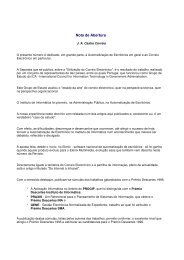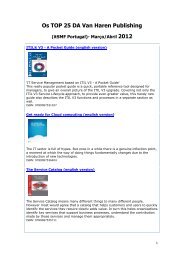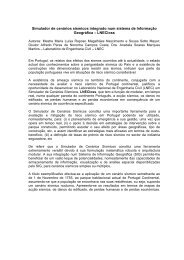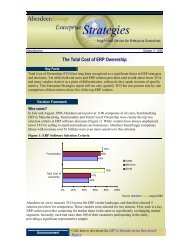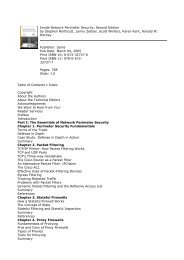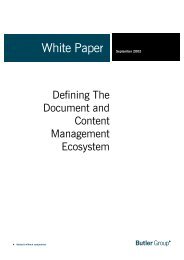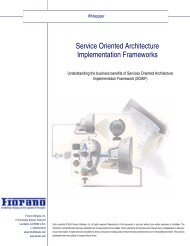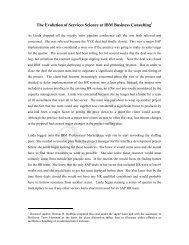OECD Peer Review of E-Government in Denmark - ePractice.eu
OECD Peer Review of E-Government in Denmark - ePractice.eu
OECD Peer Review of E-Government in Denmark - ePractice.eu
You also want an ePaper? Increase the reach of your titles
YUMPU automatically turns print PDFs into web optimized ePapers that Google loves.
Social environment<br />
Danish society uses a consensus-based approach to f<strong>in</strong>d answers to the questions that confront it<br />
– a situation that mirrors the political environment.<br />
Danes express the highest levels <strong>of</strong> satisfaction with “the way democracy works” <strong>of</strong> any EU<br />
citizens. In a survey conducted <strong>in</strong> 2001, 93% responded that they were either very or fairly satisfied<br />
with the way democracy worked. In 2003, trust <strong>in</strong> Danish politicians was at its highest level s<strong>in</strong>ce first<br />
measured <strong>in</strong> 1971.<br />
The public sector appears to benefit from these public attitudes. Danes exhibit high levels <strong>of</strong> trust<br />
<strong>in</strong> government, which is notably transparent and free <strong>of</strong> corruption. Danes have an overall will<strong>in</strong>gness<br />
to <strong>in</strong>teract with the State, and there is a general satisfaction with public services, creat<strong>in</strong>g a positive<br />
environment for e-government implementation.<br />
Economic environment<br />
<strong>Denmark</strong> has been near the top <strong>of</strong> the <strong>OECD</strong>’s <strong>in</strong>come rank<strong>in</strong>gs for many years – its 2003 per<br />
capita GDP <strong>of</strong> USD 29 800 was 15% above the <strong>OECD</strong> average. In the period 1993-2003, the average<br />
annual growth <strong>in</strong> GDP was a little below total <strong>OECD</strong> (2.25% compared with 2.6%) and considerably<br />
above that <strong>of</strong> the Euro area (1.8%). However, <strong>in</strong> both 2002 and 2003 the annual growth <strong>in</strong> GDP was<br />
well below the <strong>OECD</strong> average, with growth <strong>in</strong> 2003 be<strong>in</strong>g 0.4%, although growth was very close to<br />
the Euro area.<br />
Over the last few decades, <strong>Denmark</strong> has changed from be<strong>in</strong>g an agricultural/<strong>in</strong>dustrial society to<br />
becom<strong>in</strong>g a service society, with almost 75% <strong>of</strong> all employed persons work<strong>in</strong>g <strong>in</strong> the service sector. In<br />
2002, there were about 280,000 enterprises <strong>in</strong> <strong>Denmark</strong>, the majority be<strong>in</strong>g small and medium-sized<br />
enterprises: 55% had no employees, 36% had one to n<strong>in</strong>e employees, almost 8% had between 10 and<br />
99 employees and only 2,200 (0.8%) had 100 employees or more. However, the latter category<br />
represents 62% <strong>of</strong> total employment.<br />
<strong>Denmark</strong> has the most equal <strong>in</strong>come distribution among <strong>OECD</strong> member countries, partly because<br />
<strong>of</strong> its comprehensive welfare state. Given an age<strong>in</strong>g population, a key economic challenge is to<br />
ma<strong>in</strong>ta<strong>in</strong> growth <strong>in</strong> liv<strong>in</strong>g standards while preserv<strong>in</strong>g the social welfare system. Accord<strong>in</strong>g to<br />
population projections, the work<strong>in</strong>g part <strong>of</strong> the population (<strong>in</strong>dividuals aged 25-64 years) will decl<strong>in</strong>e<br />
by 13% over the next four decades, while the population aged 65+ will <strong>in</strong>crease rapidly from 15% <strong>of</strong><br />
the total population <strong>in</strong> 2004 to 23% <strong>in</strong> 2050.<br />
The <strong>Government</strong>’s approach to address<strong>in</strong>g this challenge, laid out <strong>in</strong> the year 2000 <strong>in</strong> its 10-year<br />
economic framework called A Susta<strong>in</strong>able Future - <strong>Denmark</strong> 2010 (“the 2010 plan”) is to boost<br />
employment, restra<strong>in</strong> public spend<strong>in</strong>g growth and pay down debt. The Danish public sector is large,<br />
provid<strong>in</strong>g over one-third <strong>of</strong> jobs. Achiev<strong>in</strong>g efficiency improvements <strong>in</strong> the public sector will have an<br />
important impact on the fiscal susta<strong>in</strong>ability <strong>of</strong> the welfare state. <strong>Denmark</strong> has recognised that<br />
achiev<strong>in</strong>g these improvements requires, among other th<strong>in</strong>gs, public <strong>in</strong>vestment. In Invest<strong>in</strong>g <strong>in</strong><br />
<strong>Denmark</strong>’s Future, 2001 (the public <strong>in</strong>vestment strategy that is one <strong>of</strong> the responses to the 2010 plan)<br />
there are two particular measures that have a direct bear<strong>in</strong>g on e-government – <strong>in</strong>vest<strong>in</strong>g <strong>in</strong> <strong>Denmark</strong>’s<br />
transition to be<strong>in</strong>g a knowledge-based society with <strong>in</strong>creas<strong>in</strong>g use <strong>of</strong> ICT, and develop<strong>in</strong>g more<br />
efficient public adm<strong>in</strong>istrative procedures to free resources for care and nurs<strong>in</strong>g.<br />
163



